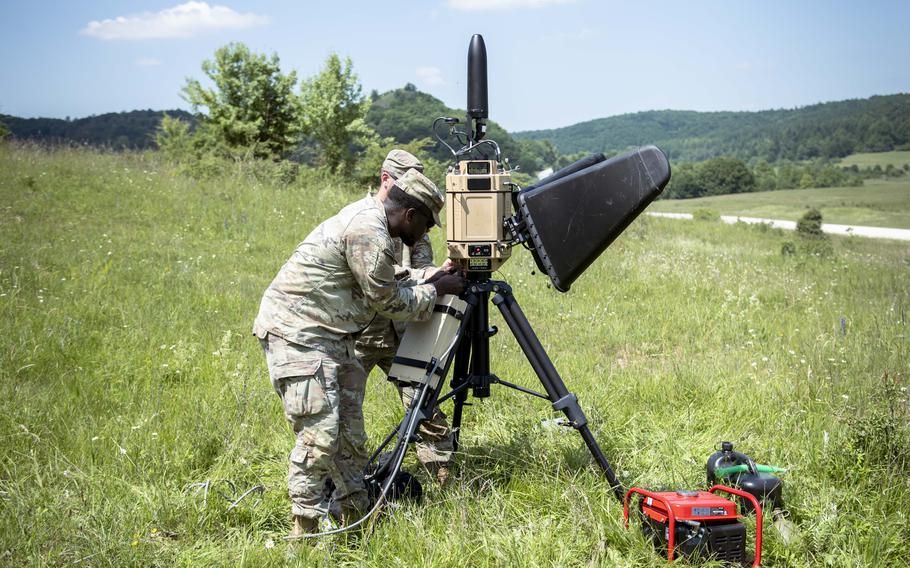
Alex Miller, the Army's chief technology officer, right, discusses planning efforts for the counter-drone Project Flytrap with soldiers at the Joint Multinational Readiness Center in Hohenfels, Germany, on June 18, 2025. (Lydia Gordon/Stars and Stripes)
HOHENFELS, Germany — An array of new drone-busting technology went for a soldierly spin this week at the Army’s expansive training grounds in Bavaria, where units are looking for a tactical edge on a transforming modern battlefield.
Troops from the Vilseck-based 2nd Cavalry Regiment took part in a new initiative called Project Flytrap at the Joint Multinational Readiness Center, using vehicle-mounted and wearable systems designed to detect, track and jam hostile drones.
The initiative is part of an effort to identify which tools best meet evolving combat demands. Project Flytrap, which began its first stage earlier this month, is a high priority for Army leadership, said Col. Donald Neal Jr., the regiment’s commander.
The Hohenfels training is the latest effort by the Army to incorporate more sophisticated drone warfare tactics into small unit formations.
It coincides with a broader U.S. military push to draw lessons from the Russia-Ukraine war, where cheap drones have been used to destroy everything from advancing infantry units and tanks to advanced Russian bombers.
Among the systems being tested are the Wingman and Pitbull wearable devices as well as EchoShield radar systems mounted on vehicles.
“This (project) … has been paramount for us,” Staff Sgt. Matthew Salinas, a master unmanned aerial systems operator with the regiment, said Thursday. “(It) has been allowing us to be able to be ahead of the curve.”
Working in tandem, the Wingman detects drones and sends pings to an earpiece worn by the user, while the Pitbull jams them using radio frequencies. The EchoShield adds long-range detection and tracking capabilities.
“With the equipment that we’ve been given … these soldiers at even the lower levels are able to easily detect and engage these drones,” said Pvt. Khadrae Graham, an infantryman. He added that the EchoShield allows him to track drones up to roughly 9,000 feet away, including their direction and speed.
Troops also mounted the Smartshooter system to their rifles. It uses artificial intelligence to track and lock on to aerial targets, enabling more precise targeting and engagement.
“You don’t have to worry about it,” said Pfc. Genrikh Kovalchuk, also an infantryman. “Just put (the rifle) on semi, squeeze the trigger and then the computer itself will realize when you have to actually let that round go and hit the drone.”
Alex Miller, the Army’s chief technology officer, observed the exercise and worked with soldiers to assess usability and integration at the squad level.
He said the goal is to develop tools that are practical and economical.
“What we’re trying to do is figure out how … we build something that’s a couple thousand dollars to destroy something that’s only a couple thousand dollars,” Miller said.
Miller outlined the counter-drone process as a three-part sequence: sensing, deciding and acting.
The focus is on identifying affordable radar systems that tie everything together with a network and then selecting electronic warfare tools “to either jam it or knock something out of the sky before we have to blow it up,” he said.
Neal, the regiment commander, said the unit is in the third phase of the project. The previous stages involved data collection and systems familiarization.
The project will culminate in August with live-fire drills in Poland that will put the new technology to the test.

Soldiers set up the Pulsar counter-drone radar and jammer at the Joint Multinational Readiness Center in Hohenfels, Germany, on June 19, 2025. The Pulsar is a machine learning-enabled radar capable of long-distance jamming. (Lydia Gordon/Stars and Stripes)